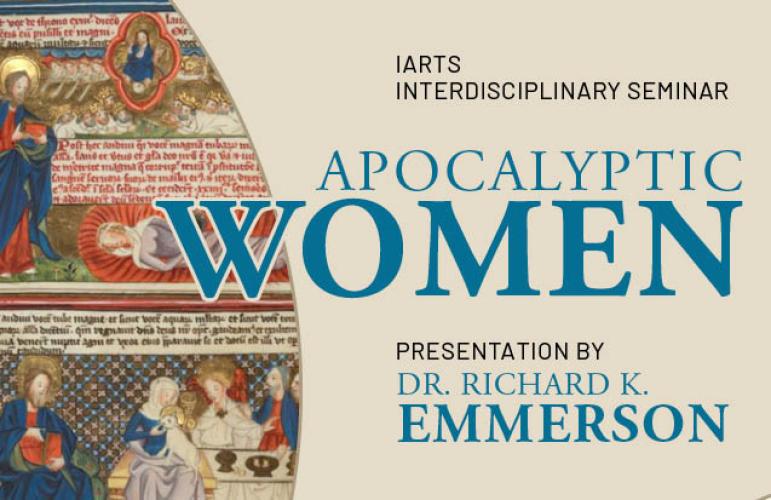
Visiting Scholar imparts vast knowledge on Medieval Apocalypse manuscripts for themed Interdisciplinary Arts seminar

Scholar Richard Emmerson shared his apocalypse-related subject expertise with this year’s seminar for Interdisciplinary Arts students and for other students and faculty across campus. The theme for this year’s seminar is Visions of the Future, so what more iconic vision of the future could there be than representations of the Apocalypse?
Emmerson serves as a visiting distinguished professor of Art History at Florida State University. He has published seven books since 1981 and authored more than 50 articles that focus on the relationship between text and image in Medieval illustrated manuscripts. His most recent publication, Apocalypse Illuminated: The Visual Exegesis of Revelation in Medieval Illustrated Manuscripts, is a culmination of many years of study and research that surveys the 700-year history of Medieval Apocalypse manuscripts. In 2009, he received the Medieval Academy Award for Excellence in Teaching Medieval Studies and has been a fellow of the Medieval Academy of America since 2011.
With a doctorate in English and now teaching in Art History, Emmerson has moved between disciplines making him a perfect example of the value of interdisciplinary studies and research. His lecture on four apocalyptic women caters to interdisciplinary studies as he focuses on historical art materials and the way feminist scholars have interpreted the Book of Revelation.
“It was not until recently that I started reading about feminist theories on The Book of Revelation, and it raises questions that I have not asked,” says Emmerson. “So, I want to show how bringing a different discipline to bear affects the way we see things. It is like when you go to a conference and hope that people will not only improve your paper but look at an area you have not thought about before. You learn from each other. This is a positive that I believe we see in a lecture like this. We learn from each other.”
Charles Buchanan, associate professor of Interdisciplinary Arts, invited Emmerson for this lecture through the College of Fine Arts’ Visiting Artists and Scholars Committee to connect the research he has done over the past 40 years with this year’s seminar theme, Visions of the Future. His virtual lecture took place on October 14.
“This lecture demonstrated how artistic images from the past provide insight into our present lives,” says Buchanan. “With students from all schools in the College of Fine Arts and outside of the college participating, we learned how issues of visions of the future cross disciplines and how Medieval artists visualized them. At the same time, we learned how St. John, who composed the Biblical text, conceived of women and how current feminist scholars interpret his text.”
While there is no substitute for being in a classroom together, everyone joining the lecture was provided pre-reading material and came prepared with questions and discussion points, allowing for an engaging, conversational environment despite the virtual format. Emmerson also offered virtual office hours prior to the lecture for interested students to meet with him one-on-one.
“There is something exciting about sharing the work you do with someone else who will appreciate and be excited about it,” says Tyler Thress, doctoral student in Interdisciplinary Arts. “It was great to have the ability to talk with Emmerson about my research because he has lived, breathed, and studied this text for four decades. It was an invaluable experience.”
Despite the lack of normalcy due to the pandemic, the School of Interdisciplinary Arts found a way for students to connect and interact with Emmerson, a scholar whose knowledge is worth the compromise of a virtual discussion.
“There is no substitute for finding the people that are interested in the subject you are interested in or an aspect of it and comparing notes in a way,” says Thress. “Having Dr. Emmerson come and speak with us was an opportunity for us to experience what he is researching and how he approaches the material he deals with. It is all about having a big toolkit.”
